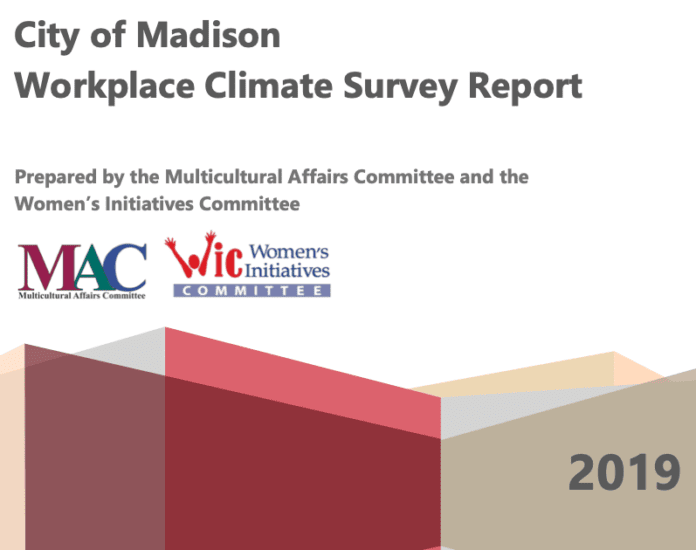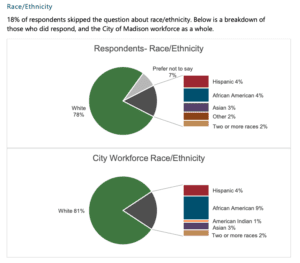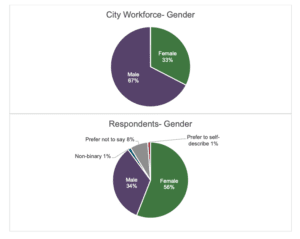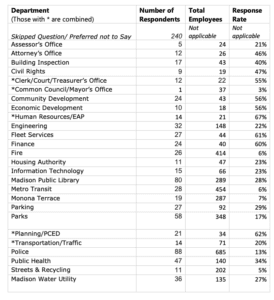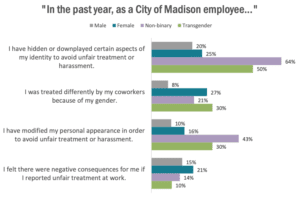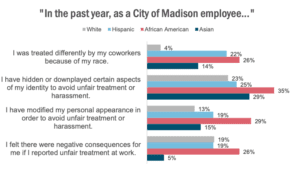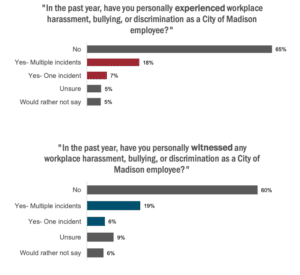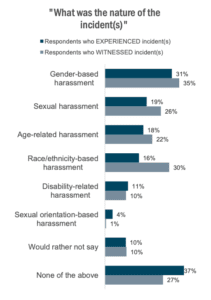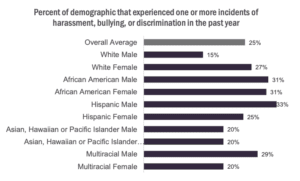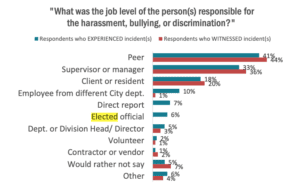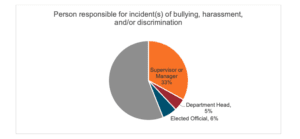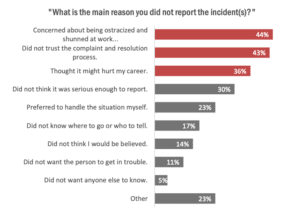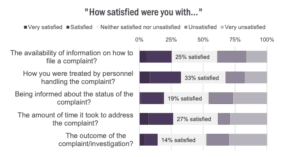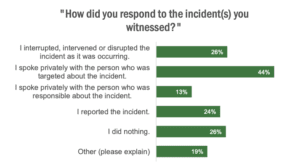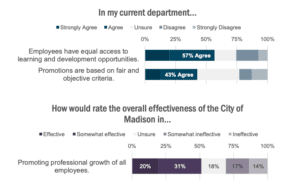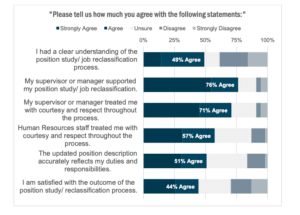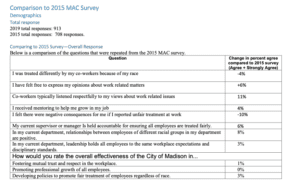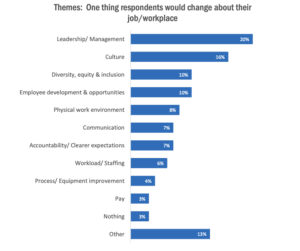Seems like we have a lot more work to do on gender equity. The report is a very interesting read. There was even a comment about me/the mayor in there! Sigh.Here is the full report. The appendix has more specifics about the summary data and the qualitative data. I have to say, after reading the comments in the appendixes I have two take aways that don’t seem to be emphasized but seemed significant. One is that staff have a huge issue with management, leadership and department heads being disconnected and not listening. The other is that women don’t feel like they get promoted, are respected. Seemed like the comments were more about gender equity than race equity, but perhaps that is due to who filled out the survey? Anyways, I don’t see those two things so much in the executive summaries as I would have expected based on the comments.
Summary of the Findings – Executive Summary/The Headlines
Themes of what the survey found:
Safe/Respectful Workplace Concerns
- One out of four survey respondents (25%) said they had experienced workplace harassment, bullying, or discrimination in the past year.
- Less than half of respondents reported their experience with harassment, bullying or discrimination. The main reasons these respondents didn’t report is because of the fear of social retaliation (being ostracized or shunned at work), closely followed by not trusting the complaint process or outcome.
- Respondents said most of the harassment and bullying was instigated by peers (40% of incidents), supervisors (33% of incidents), and patrons/members of the public (18% of incidents). Multiple employees in frontline positions described a hostile work environment where patrons/members of the public harass and verbally abuse staff with impunity. Some employees reported being stalked or physically assaulted.
Employee Development
- Less than half of respondents had a clear understanding of how to move their career forward or had received mentoring to help them grow in their job.
- Only 57 percent of respondents believe employees have equal access to learning and development opportunities.
- Of survey respondents who participated in the position study process, only half (49%) had a clear understanding of the process and even fewer (44%) were satisfied with the outcome.
Recommendations
1. Ensure a safe and respectful workplace environment for all employees.
a.) Review and improve policies, procedures, and work rules (including APMs 3-5, 2-25, and 2-33) as they relate to workplace harassment, discrimination, bullying, and violence.
b.) Evaluate and improve harassment prevention and response training for supervisors and all staff.
c.) Develop and implement clear, proactive policies to protect employees in frontline and service positions from harassment and abuse by patrons, customers, and members of the public.
d.) Review rules of conduct and training for elected officials and committee members to ensure they include provisions for appropriate treatment of staff.
e.) Develop a reporting process for employees who wish to maintain anonymity to share concerns about their workplace. (Employees would continue to have the right to make formal complaint at any time.)
f.) Plan for continuous communication and outreach to ensure employees understand their rights, how to report incidents, and who can offer them support.
g.) Increase communication with individuals who file reports to ensure they understand the process, are aware of timelines, and are not experiencing retaliation.
2. Equitable access to professional development opportunities and mentoring.
a.) Use data and metrics to identify risk areas, set targets and goals, and measure the impact of initiatives.
b.) Review and update training policies (including APM 2-10) to include provisions and measures for equity, and inclusion. All City employees should have fair and equal access to learning and development opportunities regardless of their job classification, department, and social circumstances.
c.) Support and expand targeted training programs such as Women’s Leadership Conference that are designed to eliminate barriers and underrepresentation in all levels of leadership.
3. Assess and support pay equity within our organization, specifically as it relates to race and gender
a.) Conduct regular citywide pay analyses to determine and track any disparities.
b.) Address any gender and race/ethnicity gaps analyzed by involving those who are impacted and collaborating with MAC, WIC, and other Citywide initiatives.
c.) Analyze the City’s position study process through an equity lens.
Report Findings – Digging Deeper
Who filled out the survey?
913 of about 3,000 employees.
Race. 7% chose not to reveal their race. I’m not entirely sure what conclusion to draw from that.
Gender. Only 33% of the city workforce is women? That’s a little disturbing. I mean, I have a long history of writing about the lack of women in the leadership, salaries of women in city hall and lack of appointments to committees of the city, but 33%? (here’s more, when I remembered to tag properly)
I’m shocked that the does not include non-binary/third gender/genderqueer or other option besides male and female. The survey included it, but noted: “Currently the City only provides two options for gender, male and female, so it is not known how many City employees are non-binary or genderqueer.”
Who responded to the survey? 26% wouldn’t say what department they were in. 240 of the 913 responses, that seems pretty high. Again, not sure what that is saying, except maybe indicating a lack of trust.
What did the survey find?
Who experiences workplace marginalization? No surprises, women, non-binary and transgender persons.
“There is a culture of treating female, long-term employees in my organization as ‘legacy staff’ which is coded for language meaning that their opinions and experiences are not recognized as valuable.”
“I fear that if were to be open about my gender identity in the workplace, I would face discrimination. People would treat me differently.”
Who hides or downplay aspects of their identity? No shockers here either, people of color.
“Overt bullying is rare in my experience but microaggressions abound towards black employees especially and take a significant toll. Black women in particular have told me they have been downgraded in performance appraisals for aggressive behavior’ for asking questions or speaking up. Black women have had work rules selectively enforced against them or interpreted differently towards them.”
“…in the world of #metoo and #timesup who advocates for the heterosexual Black Male, and other people of color. This question will never be answered because the answer is simple and no one wants to admit it. However I will attempt to answer it for myself by stating ‘no one’.”
“…what I have experienced and witnessed has been at the level of micro-aggressions, stereotypes perpetuated verbally and in writing on a performance evaluation, etc. These are not legally “prosecutable” or whatever violations, but they are significant perpetrators of a racist and sexist environment. And therefore worth mentioning.”
Harassment, bullying or discrimination.
Now I”m just getting sad . . . gender-based harassment and sexual harassment were the highest, along with age discrimination. This might be getting a little to personal for me! I’ve experiences quite a bit of both in the last year and a half. Race accounted for 30% of the incidents.
“Behaviors included yelling, verbal abuse, microaggressions, discrimination, condescension, theft, destruction of personal property, stalking, and even physical assault.”
“I would like to know how to respond to someone when they say something sexist or racist. Decades of being “polite” is having a negative impact on my health and having private sideline conversations to address the issue is proving ineffective. Please create a manual on how to address Xenophobia during the meeting/office party/ lunch/etc.not after. I am so tired of people feeling so free to say whatever they please, but I have to be delicate about addressing it?!?! Why doesn’t HR do something about these people?”
Who’s doing the harassing?
Interesting that 6% is from elected officials? Wonder if that changes with Soglin gone?
“While this was not textbook harassment or discrimination, I find that many white male department heads behavior is rude, male-dominated, and dismissive of female leadership.”
“When this supervisor is not happy she subtly bullies the people who report to her, especially the women.”
“I did not file a formal complaint because this was a director of a department.”
42% of incidents are not reported
“When larger complaints do not result in discipline or change, it’s not worth reporting smaller ones.”
“It’s unclear how we should report bullying behavior from an elected official…”
“When I have reported issues in the past I was told to make more of an effort to work with the person.”
“Working in a uniform with the public, I am harassed daily for my gender. I don’t see the need to report every single instance.”
“When another female employee told me of a similar incident with the same harasser I suggested she not report it because of the negative experience I had.”
“No real recourse if it isn’t based on gender or race.”
“I don’t want to be seen as a big baby or as too sensitive…”
And when reported, the satisfaction rate is low
“I don’t know how to make a formal complaint. I shared my concerns with my supervisor.”
“Lack of communication on timeline and outcome was disappointing.”
“With no follow up on the complaints or positive changes in the behavior of the person who committed the discrimination and harassment, it does not seem helpful to report incidents. Reporting has only made matters worse for me as an employee within the organization.”
“Because the offender has been here longer than I have, the issue was not taken seriously.”
Bystanders – 26% did nothing
“I was asked by the person not to intervene.”
“I do try to stick up for people as these things occur because my career is already damaged by my reporting of ongoing issues with this person…”
“I tried to change the conversation, rather than directly confront this individual making the inappropriate comments.”
“I would never report without the consent of the victim.”
“The jokes, non-constructive criticism, nicknames of non-present people, and overall shaming are very hard to deal with. However, I’m not sure any of it rises to the level of harassment. And how would I ever prove it anyway. Especially when I’m the only one that doesn’t seem to like it and/or participate.”
“I have witnessed micro-aggression but not necessarily anything that rises to the level of harassment.”
Poor satisfaction for learning/development and promotions
7% or 58 people who answered the survey had gong through the reclassification process and there were not positive results. My observations have been that some departments are much better at this – and get better cooperation from HR.
“It took over 2 years. It was ridiculous. And even if it didn’t change much within the city, it is not in line with my industry as a whole…”
“We were not notified of the new classification study process… Discovered it after the fact when it went before the Personnel Board.”
“HR did not explain the process to me, and the result was what that they updated the position description but did not recognize the significant increase in responsibilities. They still don’t know what I do.”
“The outcome didn’t increase my level nor my salary and it result in toking away the unique position and duty I was hired for.”
“I find it horrible to re-class a job for a person, but open it to others, giving false hope to many and leaving resentment in the path…”
Gender Pay Equity
Selected comments from the survey
“Citywide gender pay inequity is a serious problem. There are many female supervisors/managers who are being classified as Coordinators to keep their pay down even though they are doing the work of their male counterparts who are paid as managers.”
“We are told there is NO MONEY in the budget for this!”
“There is a gender pay gap in the city because of outdated classifications and salary ranges.”
Local 6000 has been pushing for a reclassification study of administrative positions for many years but HR… have not been willing to work on it. If gender equity and womans issues are a priority of the mayor this study should be prioritized.
Report Recommendations – Digging Deeper
Suggestions to improve the position study process – from survey comments:
“More engagement with the employee. This was a yearlong process and I had one meeting with HR and none with my supervisor.”
“Should be based on an objective study of the position as it is now, and on comparison to other positions. Should not be related to the position history.”
“It would be helpful to receive an outline of the process from HR once the information is submitted. This way, I know what to expect in what timeframes instead of wondering if it has been dropped during a communication gap.”
“We should look at the rest of the organization and not just that job at the time of the study, some jobs get reclassified higher or equal to jobs with more responsibility.”
“Get as much information as possible from the general job market, not just other city positions.”
“I am in the process of this… It would be helpful to have a written document to explain it… I am not confident I am producing information that will help my case for reclassification.”
Additional Survey Findings
Here’s a few things I found of interest:
Clients and residents of the city being harassed, bullied or discriminated against (10%), as well as elected officials (1%):
Changes from the 2015 Study
There seems to have been small increases in satisfaction and improvements.
Additional Qualitative Data
Ok, I was surprised to find this comment when I was looking for how elected officials were harassing people. Then again, I wasn’t that surprised.
Question 6: “If you could change one thing about your job or workplace, what would it be?”
I have spoken to several people of different backgrounds who have been a part of teams or panels related to cultural diversity. I have not been a part of any of these panels. It seems, based on the discussions that we have had, that the City wants to appear to respect culture and diversity, but does not want to actual have the difficult discussions that could improve our environment. This includes how to better the life of people we serve. Oftentimes it seems like money is extremely wasted in one area, I/e, $400,000 study of the department, while it is sorely lacking in other areas. Further, this is both a big and little City. Our differing City agencies are often intertwined and work together. It is incredibly offensive and disappointing to see so many representatives of our City bemoan and or speak out against the Police Department simple because we are the “”police.”” This is one area in which I am often the most offended. In any other profession, were I to judge someone solely on one facet of their life, such as a career, I would be chastised and reprimanded, and rightly so. Yet the representatives of our city are allowed to constantly do that to me, and my fellow co-workers, without further reprimand? Even worse our newly elected mayor chose to nominate a well known, and unapologetic critic of the police, to the PSRC? The questions above are difficult to answer, because there are many here that do care for me, and have supported me and others repeatedly in the past. However, when our judicial system, yes Madison and Dane County included, treats suspects with more respect and reverence than those trying to uphold the law I become concerned. Further I do not know with certainty that I am being treated fairly because of this.
Other things people would change about the workplace?
What action could your department take to reduce gender discrimination?
Question 8 on the survey asked, “Q8. In April, the Common Council adopted a resolution affirming the fundamental principles of human rights and equality for women in our community. What action (if any) could your department take to reduce gender discrimination?” There were 426 responses to the question. Themes in the responses included hiring more women, especially in positions of leadership, providing more development and promotional opportunities to women, pay equity, addressing issues with harassment and discrimination, and doing more to promote an inclusive culture. Some comments also said more work should be done to deconstruct the gender binary and to educate staff about LGBTQ issues. Other respondents said gender discrimation was not an issue in their department, either because their department led on these issues, their department lacked gender diversity, or they were concerned about discrimination against men.
Words used to describe the workplace?
Responses included over 800 unique words and phrases, even after derivatives were combined (stressed/stressful, collaboration/collaborative, etc.). “Supportive” was the most frequently used word, appearing 69 times. This was followed by “Friendly” (67 appearances), “Positive” (51 appearances), “Collaborative” (42 appearances), and “Fun” (40 appearances). The most frequently used negative words were “Stressful” (27 appearances), “Toxic” (23 appearances), and “Siloed” (19 appearances). The words “Busy” (22 instances) and “Challenging” (13 instances) can be either positive or negative depending on the context.
Some responses of interest. While there were lots of upbeat and positive responses and even some saying there are improvements, still there are these comments. Hard to tell if they are from different departments or different people in the same department.
“The Borg Evolving”
Trout, Banana, Piano Bonus words: Vigilance, Caution, Changing with a new administration
meh
Swell
welcome to oz
It sucks donkeyballs.
Old Boys’ Club
Stagnant, archaic, bro-topia
MANDATORY PANTS CULTURE
highest level are noshows
Stop sending Survey!
Passive aggressive behavior
Toxic, Entitled, Bias
sad, sad, sad
Antiquated
regimented status-quo old-fashioned
As a driver: Present, on time, safety As an instructor: present, say nothing, your opinion doesn’t matter
good old boys
We are 99% the same race. Hard to answer these questions.
Good Old Boys
directionless, frustrated, hostile to female authority
males are first
siloed (information or project work is not shared agency-wide), top-down, clique-ish (“clubby” favoritism)
boys club, slow, but progress
Good ole boys
Unfair, Draining, Relentless
messed up!
Political correctness nonsense
mistrusting of managers
ripped ab muscles
Culture: intense, downhearted, Environment: thankless
discriminatory, divisive, bullying
double standards
Blacks do nowrong
Non-transparent, overworked, unappreciated
Upper management disconnect
toxic, substandard, elitist
Friendly, casual, inconsistent
racist, unaware, toxic
Implicit/outward biases discrimination, unjust and depressing.
inconsistent, unequal, confusing
overworked, underappreciated, low-morale
dedicated, caring, unmotivated (no vision by supervisor)
busy, overworked, under respected
Disconnected, disorganized,
Stale, static, disgruntled
lazy, don’t care.
Strained, archaic, devoid-of-strong-leadership. Very Hostile environment
tense, political, frustrating
Unsupportive, Unsympathetic, Intolerant toxic, depressing, demanding
favoritism, secretive , autocratic
Not diversify enough
Inclusive (positive), complaint-ridden (negative), inconsistent (negative)
Frustration
Distrust, Paternalism, Service
Dissatisfied, disrespectful, inconsistent
Stressed, cliquey, shallow
toxic, disrespectful, chaotic
Hostile unfair sickening
very VERY WHITE.
toxic, inequitable, lack of accountability at leadership levels
disconnected, hectic, unfocused
Siloed, Disengaged, Secretive
chaotic
Cronyism, zero communication, incompetence
disorganized, unfair, punitive
learning organization, dysfunctional, doing the best they can to address racial equity
distrusting, disorganized, exhausting
play’s favorites/can do no wrong.
toxic, biased, arbitrary
Unfair, toxic, unresponsive
clique; disinterested; unhappy
Unfair, selfish, uneducated
short-sighted, hierarchical, extensive absenteeism
Toxic. Toxic. Toxic.
Uncertainty, discontent, & unfair.
Walking on eggshells
toxic, stressful, bias
Chaotic; poor executive leadership; disconnected
Toxic cultural and environmental
Nervous. Skeptical. Anxious.
lacking group identity (each location/department acts separately, very little interaction
Top down system.
Friendly, risk and conflict adverse (supports white, cis, male, hetero dominant culture), well- intentioned
Negative, toxic, frustrating.
authoritarian managers overrule
Unsafe, over worked, under valued
White Male dominated
Discriminatory, Deprivation, Discourteous
Over-worked, secretive, hierarchical
Avoidance, Messy, Structure (Old)
staffing, apathetic, cold
Biased, stubborn, set
Divisive, somewhat hostile.
improving, supportive, maybe a bit enabling
Toxic, Destructive, Unfriendly
Uneven workloads, scattered communication across areas of expertise within unit AND Division, however Improving from previous rock bottom
Friendly, relaxed, white
underlying sexism, descrimination
stressed – unequal – unsupported
UN-FAIR, UN-PROFESSIONAL, UN-ETHICAL
Silo, traditional, reactive
male dominated, friendly
Toxic. Dictatorship. Bias.
unsafe, unfair,demoralizing
Tense, compartmentalized, unfriendly
Siloed, Rogue, Judgmental
secrecy, rudderless, and micromanaged
Collaborative, Coasting, Hopeful, but possibly misguided, incrementalism
challenging, whimsical, demeaned
Low morale, toxic
Morale is poor
strongly biased
intimidation, uncertainty, punitive
nice white women
Old white men
Clique’s, Privilege
Reactive, under-staffed, bad-project-planners
male-dominated, underrepresented, stressful
disconnect, tension, distrust
Immoral. Unethical. Bias.
Professional, Ultra-liberal (politically)
never-ending-scrutiny
Hostile, uninspired, crabby
biased towards minorities
Collegial, male dominated
Divided, Polite, Hard-working
top heavy, inconsistent, silos
strained to hostile
dismissive, sexist, exclusive
Toxic, Negative, Unpleasant
Patriarchy in place
Toxic, Patriarchal, White-fragility, Willfully- ignorant
privileged white people
Unfair for whites.
focused, forward-thinking, Shitty work environment (office has never been remodeled and crap falls out of the heating vents)
Unsafe (due to homeless population and unstable patrons), Supportive, Flexible
hierarchy; classist; elitist
arrogant
Unorganized, Obstructionist, Non-Functional
dysfunctional, divisive, hostile
Not diversified at all
I think OUR culture is fine. It’s dealing with the rest of the city I have issues with
Tempestuous
unforthcoming, exclusive, unanswerable
white, male, heterosexual
Old Boys Club
Try going unnoticed
Favoritism, seniority based
Toxic, Unfair, Bias
disorganized, knowledge/power hoarding, not transparent
managed for effect. Managed for how it looks
disengaged, tired, unprepared
Managers share nothing
Unsafe, overburdened, understaffed
Not honest enough
strained. evidence of favoritism
Dormant, Political, Complex, Demanding
siloed, manager-heavy, management-disconnect
gender biased club
Off kilter, out of balance, unfair.
segregated, improving, top down
boys club
Defeated, Sarcastic, Unappreciated
regimented, impersonal, distracting
discreet, rigid, favor
Fear, low-morale, hierarchical
fun, loud, masculine
Other answers to “If you could change one thing about your job or workplace, what would that be?”
The large amount of comments about leadership, management and department heads seems significant here. You can take a look, there are responses regarding the following:
- leadership and management (6.5 pages)
- Workplace culture (4-5 pages)
- Diversity, equity and inclusion (3 pages)
- Employee development (3 pages)
- Physical work environment/facilities (2.5 pages)
- Communication (1 page)
- Accountability (1 – 2 pages)
- Workload and staffing (1 page)
- Process and equipment improvement (1 page)
- Pay and pay equity (half page)
- Change nothing (half page)
- Other (4 pages)
Answers to “What action could your department take to reduce gender discrimination”?
- Employee development (2.5 pages)
- Pay and pay equity (2 pages)
- Harassment and discrimination (1.5 pages)
- Hiring and Recruitment (2.5 pages)
- Parental policies (.5 page)
- Gender diversity in department (.5 page)
- Inclusion (.5 page)
- Not an issue (2 pages)
- Reverse discrimination (1 page)
- Training (1 page)
- Workplace culture (.5 page)
- Other (3 pages)
Other comments
- 10 pages of other comments
CONCLUSION
It’s worth taking a deeper dive into the comment section in the appendices.

